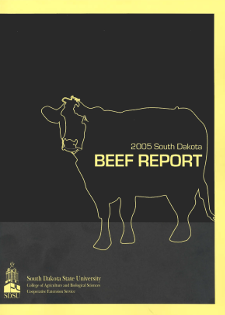Document Type
Report
Report Number
2005-13
Publication Date
2005
Keywords
dry distiller's grains, solubles, steers, feedlot performance, nutrient management
Summary
A study was conducted to determine the effects of feeding varying concentrations of dried distillers grains with solubles (DDGS) to finishing steers on feedlot performance, nutrient management, and odorant emissions. Prior to initiation of the trial, 192 steers (initial BW = 826 ± 18 lb) were blocked by receiving date, weighed, and randomly allotted to 16 dirt floor pens (48.2 ft x 113.8 ft; 5% slope). Pens were then randomly assigned to one of four dietary treatments. The control diet (CON) contained 82% cracked corn, 10% alfalfa hay, 4% molasses, 3.2% supplement, and 0.8% urea. In the remaining three treatment diets, all of the urea and portions of the cracked corn were removed and replaced with DDGS at 15% (15% DDGS), 25% (25% DDGS), and 35% (35% DDGS) of the diet DM. The diets were formulated to be isocaloric and to provide similar levels of crude protein (CP) for CON and 15% DDGS (13.2 and 13.3% CP, respectively) and a stepwise increase in CP for 25% and 35% DDGS (15.4 and 17.6%, respectively). Analysis of weekly feed samples collected throughout the trial determined that the CP concentrations were 11.4, 12.2, 14.3, and 16.5% for CON, 15% DDGS, 25% DDGS, and 35% DDGS, respectively. Cumulative dry matter intake (DMI) was greater (P < 0.05) and ADG tended (P < 0.10) to be greater for cattle consuming the 25% DDGS treatment compared to CON with 15% DDGS and 35% DDGS being intermediate (DMI = 23.7, 24.1, 24.8 and 24.1 lb/d and ADG = 4.25, 4.39, 4.55, and 4.45 lb for CON, 15%, 25%, and 35% DDGS, respectively). Dry matter intake responded quadratically (P < 0.05) as the level of DDGS in the diet increased. Steers fed DDGS also tended to consume more dry matter than steers fed the control diet (P < 0.07). There were no differences in final weight between treatments. Dressing percent and backfat increased (P < 0.05) and hot carcass weight and yield grade tended (P < 0.10) to increase in a linear fashion as level of DDGS in the diets increased. No differences were detected between treatments for marbling, kidney, pelvic, and heart fat, or ribeye area. Air samples were collected via wind tunnel at 3 locations per pen over a 3-d period prior to animal introduction and on d 78 to 80. Hydrogen sulfide levels were greatest (P < 0.05) in pens containing cattle fed the 35% DDGS treatment compared to pens with cattle consuming the remaining treatments. No differences in odor characteristics were detected between treatments. Pen floor core samples (7 per pen) were taken prior to animal introduction and upon completion of the trial. No differences were found for nitrogen (N), phosphorus (P), potassium, organic matter, pH or salt concentrations. Manure samples collected from pens scrapings were weighed and analyzed for dry matter, ammonia-N, Kjedahl-N, and Olsen-P. Ammonia-N and Olsen-P increased in a linear fashion (P < 0.05) as the levels of DDGS in the diets increased. Dried distiller’s grains with solubles can be included in feedlot finishing diets at up to 35% of DMI without negatively affecting performance. However, animal performance is maximal when DDGS is included at 25% of DMI. Changes in carcass characteristics with increasing DDGS levels may affect days on feed needed to reach optimum terminal endpoint. Hydrogen sulfide emissions from pen floors may increase as the level of DDGS in the diet increases. However, when the feedlot is the sole source of H2S, the impact of increased H2S on odor or human health is negligible. General odor detection is not affected by feeding DDGS.
Number of Pages
9
Format
application/pdf
Language
en
Publisher
South Dakota State University
Rights
Copyright © 2005 South Dakota State University
Recommended Citation
Benson, Clint S.; Wright, Cody L.; Tjardes, Kent E.; Nicolai, Richard E.; and Rops, Bradley D., "Effects of Feeding Varying Concentrations of Dry Distiller's Grains with Solubles to Finishing Steers on Feedlot Performance, Nutrient Management and Odorant Emissions" (2005). South Dakota Beef Report, 2005. 14.
https://openprairie.sdstate.edu/sd_beefreport_2005/14

